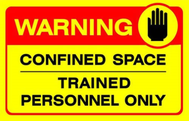- The identification of the space to be entered, the purpose of the entry, the time of entry and the expected duration of the task.
- The names of the entrants, attendants, and the entry supervisor.
- Results of any atmospheric testing for oxygen content, lower explosive limit, and toxic air contaminants, including the name of the qualified person conducting the testing.
- The control measures in place to control the hazards that caused the space to be classified as a permit-required confined space.
- A description of the hazards that may be introduced by the work to be performed in the space, and the measures in place to control those hazards.
- A description of the communications equipment and methods to be used to maintain communications between the entrants and the attendant.
- A list of the equipment to be used to conduct a safe entry and work n the space, including personal protective equipment that must be worn.
- A list of the prohibited condition that would require an immediate evacuation of the space.
- A written rescue plan that identifies the rescue service and the means for contacting the rescue services. Coordination with local contracted agencies or in-house personnel must be established and verified prior to entry.
- The signature of the confined space entry supervisor, certifying hat the space is safe to enter, and authorizing entry.

- Ensure that all closed permits are signed by the entry supervisor and are maintained for at least 1 year.
- A pre-job briefing before entry should be conducted to ensure that the task is done safely and that all elements of the PRCS standard is in place.

 RSS Feed
RSS Feed
